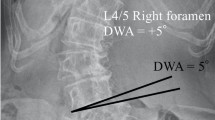Abstract
The objective of this study was to evaluate the coronal alignment of the thoracic spine in persons with dextrocardia. Generally, the thoracic spine is slightly curved to the right. It has been suggested that the curve could be triggered by pulsation forces from the descending aorta. Since no population study has focused on the alignment of the thoracic spine in persons with situs inversus, dextrocardia, and right-sided descending aorta, we compared the radiographs of the thoracic spine in persons with dextrocardia to those having normal levocardia. Among 57,440 persons in a health survey, 11 cases of dextrocardia were identified through standard radiological screening. The miniature chest radiographs of eight persons were eligible for the present study. The study was carried out as a nested case–control study. Four individually matched (age, gender, and municipality) controls with levocardia were chosen for each case. Coronal alignment of the thoracic spine was analyzed without knowledge of whether the person had levo- or dextrocardia. A mild convexity to the left was found in all persons with dextrocardia and right-sided descending aorta (mean Cobb angle 6.6° to the left, SD 2.9). Of the 32 normal levocardia persons, 29 displayed a convexity to the right, and the remaining three had a straight spine (mean Cobb angle 5.2° to the right, SD 2.3). The difference (mean 11.8°, SD 3.5) differed significantly from unity (P = 0.00003). In conclusion, it seems that a slight left convexity of the thoracic spine is frequent in dextrocardia. We assume that the effect of the repetitive pulsatile pressure of the descending thoracic aorta, and the mass effect of the heart may cause the direction of the convexity to develop opposite to the side of the aortic arch.
Similar content being viewed by others
References
Aromaa A (1981) Epidemiology and public health impact of high blood pressure in Finland (In Finnish with English summary). Publications of the Social Insurance Institution AL, Helsinki
Bellyei A, Czeizel A, Barta O, Magda T, Molnar L (1977) Prevalence of adolescent idiopathic scoliosis in Hungary. Acta Orthop Scand 48:177–180
Cobb J (1948) Outline for the study of scoliosis. In: American Academy of Orthopaedic Surgeons instructional course lectures, pp 261–275
Coonrad R, Richardson WJ, Oakes WJ (1985) Left thoracic curve can be different. Orthop Trans 9:126–127
Crawford AH, Herrera-Soto J (2007) Scoliosis associated with neurofibromatosis. Orthop Clin North Am 38:553–562. doi:10.1016/j.ocl.2007.03.008
DeSmet AA (1985) Radiology of spinal curvature. Mosby, St Louis
Ferencz CC-VA, Loffredo CA, Wilson PD (1997) Genetic and environmental risk factors for major cardiovascular malformations. The Baltimore-Washington infant study 1981–1989. In: Perspectives in Pediatric Cardiology. Futura Publishing Co. Inc., Armonk
Goldberg C, Dowling FE (1990) Handedness and scoliosis convexity: a reappraisal. Spine 15:61–64. doi:10.1097/00007632-199002000-00001
Goldberg CJ, Dowling FE, Fogarty EE (1994) Left thoracic scoliosis configurations. Why so different? Spine 19:1385–1389
Goldberg CJ, Moore DP, Fogarty EE, Dowling FE (1999) Left thoracic curve patterns and their association with disease. Spine 24:1228–1233. doi:10.1097/00007632-199906150-00010
Gore DR, Passehl R, Sepic S, Dalton A (1981) Scoliosis screening: results of a community project. Pediatrics 67:196–200
Gray H (1989) Gray’s anatomy. In: Bannister L (ed), Churchill Livingstone, Edinburgh, p 330
James JI (1954) Idiopathic scoliosis; the prognosis, diagnosis, and operative indications related to curve patterns and the age at onset. J Bone Joint Surg Br 36-B:36–49
Jordan CE, White RIJ, Fischer KC, Neill C, Dorst J (1972) The scoliosis of congenital heart disease. Am Heart J 84:463. doi:10.1016/0002-8703(72)90468-1
Kidd SA, Lancaster PA, McCredie RM (1993) The incidence of congenital heart defects in the first year of life. J Paediatr Child Health 29:344–349. doi:10.1111/j.1440-1754.1993.tb00531.x
Luke MJ, McDonnell EJ (1968) Congenital heart disease and scoliosis. J Pediatr 73:725–733. doi:10.1016/S0022-3476(68)80178-7
McCarver CL, Levine DB, Veliskakis K (1971) Left thoracic curve patterns in idiopathic scoliosis. J Bone Joint Surg Am 53:196 (abstract)
Miles M (1944) Lateral vertebral dimensions and lateral spinal curvature. Hum Biol 16:153–171
Millner PA, Dickson RA (1996) Idiopathic scoliosis: biomechanics and biology. Eur Spine J 5:362–373. doi:10.1007/BF00301963
Morisaki N, Shirasu T, Ota M, Yamagata K (1964) Spinal scoliosis associated with congenital heart diseases. Nippon Seikeigeka Gakkai Zasshi 38:699–700
Reamy BV, Slakey JB (2001) Adolescent idiopathic scoliosis: review and current concepts. Am Fam Physician 64:111–116
Roth A, Rosenthal A, Hall JE, Mizel M (1973) Scoliosis and congenital heart disease. Clin Orthop Relat Res 95–102. doi:10.1097/00003086-197306000-00011
Schwend RM, Hennrikus W, Hall JE, Emans JB (1995) Childhood scoliosis: clinical indications for magnetic resonance imaging. J Bone Joint Surg Am 77:46–53
Shands AR Jr, Eisberg HB (1955) The incidence of scoliosis in the state of Delaware: a study of 50,000 minifilms of the chest made during a survey for tuberculosis. J Bone Joint Surg Am 37-A:1243–1249
Skogland LB, Miller JAA (1978) The incidence of scoliosis in northern Norway. A preliminary report. Acta Orthop 49:635
Soucacos PN, Zacharis K, Gelalis J, Soultanis K, Kalos N, Beris A, Xenakis T, Johnson EO (1998) Assessment of curve progression in idiopathic scoliosis. Eur Spine J 7:270–277. doi:10.1007/s005860050074
Taylor JR (1986) Vascular causes of vertebral asymmetry and the laterality of scoliosis. Med J Aust 144:533–535
Willner S, Uden A (1982) A prospective prevalence study of scoliosis in Southern Sweden. Acta Orthop Scand 53:233–237
Yeom JS, Lee CK, Park KW, Lee JH, Lee DH, Wang KC, Chang BS (2007) Scoliosis associated with syringomyelia: analysis of MRI and curve progression. Eur Spine J 16:1629–1635. doi:10.1007/s00586-007-0472-1
Author information
Authors and Affiliations
Corresponding author
Rights and permissions
About this article
Cite this article
Tallroth, K., Lohman, M., Heliövaara, M. et al. Dextrocardia and coronal alignment of thoracic curve: a population study. Eur Spine J 18, 1941–1945 (2009). https://doi.org/10.1007/s00586-009-1049-y
Received:
Revised:
Accepted:
Published:
Issue Date:
DOI: https://doi.org/10.1007/s00586-009-1049-y




